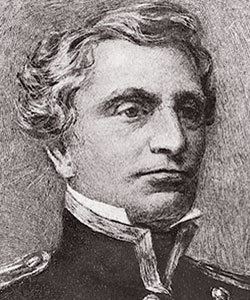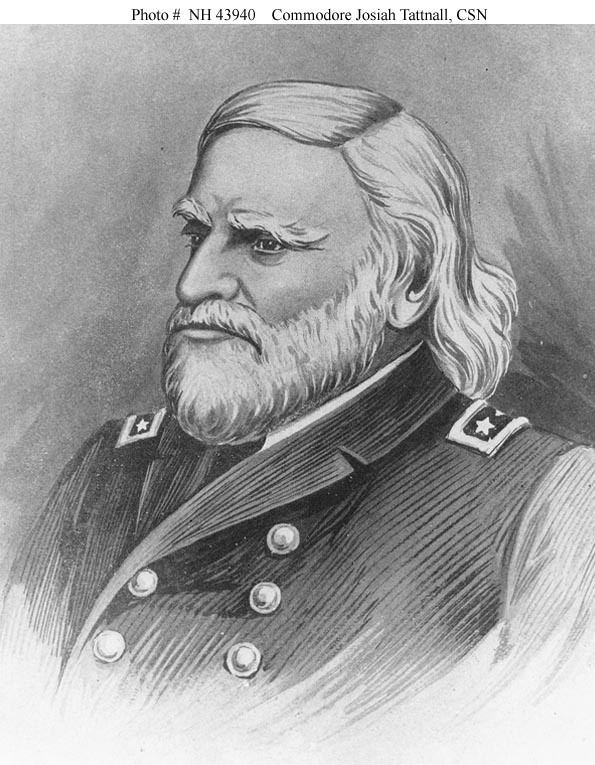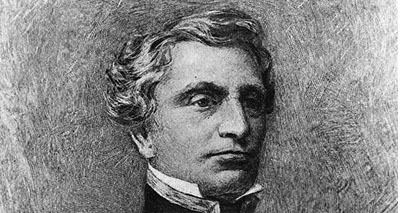Name Josiah Tattnall | ||
 | ||
Born June 14, 1794
Savannah, Georgia ( 1794-06-14 ) Allegiance United States of America
Confederate States of America Service/branch United States Navy
Confederate States Navy Years of service 1812–1861 (USN)
1861-1865 (CSN) Rank Captain (USN)
Commodore (CSN) Battles/wars War of 1812
Second Barbary War
Mexican–American War
American Civil War Died June 14, 1871, Savannah, Georgia, United States Battles and wars War of 1812, Second Barbary War, Mexican–American War, American Civil War Commands held East India Squadron, James River Squadron Similar People Samuel Francis Du Pont, Robert E Lee, Quincy Adams Gill, David Hunter, Thomas W Sherman | ||
Commodore Josiah Tattnall, Jr. (14 June 1794 – 14 June 1871) was an officer in the United States Navy during the War of 1812, the Second Barbary War and the Mexican-American War. He later served in the Confederate Navy during the American Civil War.
Contents
- Schooling and War of 1812
- Interwar Years 1818 1845
- Mexican American War
- Interwar Years 1848 1860
- American Civil War
- Namesakes
- References

Schooling and War of 1812

Josiah was the son of Josiah Tattnall who was Governor and U.S. Senator from Georgia. He was born on his father's plantation of Bonaventure, near Savannah, Georgia. After studying in England, he was appointed a midshipman on 1 January 1812 and attended the Naval academy at Washington, D.C., until 1 August when he was assigned to the frigate Constellation.

When his ship tried to slip out to sea, the strong British squadron operating in the Chesapeake Bay forced her to put into Norfolk, Virginia. Constellation remained bottled up in Hampton Roads for the duration of the War of 1812, but Tattnall and his comrades still managed to get into the fray. He was among the 100 or so sailors and marines assigned to the shore battery on Craney Island. On 22 June 1813, the British attempted to carry the island by storm in preparation for an attack on nearby Norfolk. Tattnall's battery and a force of American boats gave the attackers a sound rebuff that deterred the British from further attempts to take the city.

In April 1814, Midshipman Tattnall was detached from Constellation and, by 24 August, was in command of a force of employees from the Washington Navy Yard. He led them into the Battle of Bladensburg in an unsuccessful effort to stop the British advance on the American capital. On 14 October, he was ordered to Savannah for duty on Epervier. In May 1815, that sloop sailed for the Mediterranean with Commodore Stephen Decatur's squadron to engage the Barbary Pirates in Algiers in the Second Barbary War. On 17 June, she participated in the capture of the frigate Mashouda and, two days later, of the brig Estedio. In July, when Epervier was ordered back to the United States with dispatches, Tattnall remained in the Mediterranean in Constellation. In January 1817, he transferred to Ontario and returned in her to the United States.
Interwar Years, 1818-1845
Promoted to lieutenant on 1 April 1818, Tattnall was assigned to the frigate Macedonian on 30 June, and he sailed in her for the Pacific in November. He was detached from Macedonian on 30 August 1820, and returned to the United States. Ordered to Norfolk on 26 December 1822, he joined Commodore David Porter's squadron in schooner Jackall. Lieutenant Tattnall served in the West Indies on an expedition to suppress piracy until he was detached on 4 May 1823. On 23 June 1824, Tattnall was ordered to Constitution for Mediterranean service. In March 1826, he transferred to Brandywine and returned home in her in May. On the 15th of that month, he was granted six months leave, which was later extended into 1828.
Tattnall served in Erie from October 1828 to August 1829 and then went on to survey the Tortugas until March 1830. Lt. Tattnall took command of schooner Grampus on 15 April 1831, and cruised the West Indies and the Gulf of Mexico. In August 1832, he captured the Mexican schooner, Montezuma, which had boarded and robbed an American ship on the high seas. He was detached from Grampus in September 1832 and went on leave awaiting orders for almost four years before being ordered in, July 1836, to recruit men for Captain Thomas ap Catesby Jones' survey and exploration expedition.
Tattnall was promoted to commander on 25 February 1836, and, in April, reported for a three-year tour of duty at the Boston Navy Yard.
Mexican-American War
Following service with the Mediterranean and African squadrons, Commander Tattnall joined the Mosquito Division in the Gulf of Mexico in 1846, commanding the steam gunboat, Spitfire. During the Mexican-American War, he took part in the attacks on Vera Cruz, San Juan d'Ulloa, and Tuxpan, and he suffered an arm wound. For his gallantry before Vera Cruz, the state of Georgia presented him with a sword.
Interwar Years, 1848-1860
In 1848 and 1849, he returned to shore duty at the Boston Navy Yard. On 5 February 1850, he was commissioned captain and, the following month, was given command of Saranac. Next, he commanded the Pensacola Navy Yard from July 1851 to June 1854. From August 1854 to November 1855, Captain Tattnall was flag captain in Independence to Commodore William Mervine with the Pacific Squadron. At Hong Kong on 29 January 1858, he relieved Commodore James Armstrong taking command of the East India Squadron, breaking his flag in San Jacinto. During his two years in the Far East, Commodore Tattnall violated American neutrality while commanding the chartered steamer Toey-Wan, when he came to the assistance of a British and French squadron under fire from the Taku Forts at the mouth of the Pei Ho or Hai River. His explanation of his action, "Blood is thicker than water", subsequently became a famous slogan.
On his return voyage early in 1860, Tattnall commanded the Powhatan, carrying the first diplomatic embassy from Tokugawa Japan to the United States. While stopped at Honolulu, Hawaii along the way, the British residents of that city wrote a letter thanking Tattnall for his "gallant and humane conduct" during the "unfortunate affair at the Pei-ho River". The embassy was safely conveyed to San Francisco and then Panama, where they crossed the isthmus and continued on to Washington, D.C.
American Civil War
At the outbreak of the Civil War, Capt. Tattnall held command of the Sackett's Harbor Station. Though he opposed secession, Tattnall resigned his commission on 21 February 1861. A week later, Governor Joseph E. Brown commissioned Tattnall as the senior flag officer of the Navy of Georgia. On 26 March 1861, he received his commission as a captain in the Confederate Navy. Tattnall commanded Southern naval units during the defense of Port Royal until the harbor was captured by Union forces on 7 November 1861. From there, he moved to overall command of the defense of Virginia's waters early in March 1862. Tattnall, by then a flag officer in the Confederate Navy as well as the Navy of Georgia, directed CSS Jamestown and other warships in captures of Federal merchantmen off Sewell's Point in April 1862.
On 11 May 1862, in the face of advancing Federal forces, Flag Officer Tattnall ordered the destruction of his flagship, CSS Virginia (ex-Merrimack). He was later acquitted by a court martial of all charges stemming from that action. He resumed command of the naval forces of Georgia on 29 May 1862, and retained it until 31 March 1863, when he turned over command of forces afloat to Comdr. Richard L. Page and concentrated upon the shore defenses of Savannah. When Savannah fell to General William Tecumseh Sherman's troops, Tattnall became a prisoner of war.
He was paroled on 9 May 1865, and, soon thereafter, took up residence once more in Savannah. Captain Tattnall died there and was buried in Bonaventure Cemetery.
